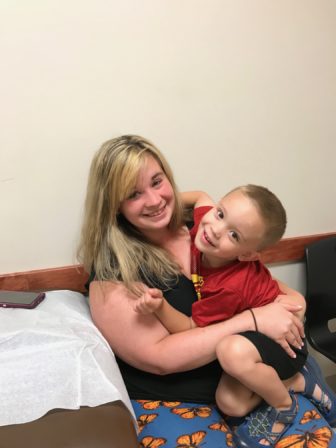By Colleen Shaddox
HUSKY members in a person-centered medical home (PCMH) practice are more likely to get recommended preventative health services and less likely to visit the emergency room, according to Department of Social Services (DSS) data.
A PCMH is a medical practice that provides comprehensive and coordinated care. That can mean helping a child get an appointment with a behavioral health clinician; making sure a patient’s apartment is free of asthma triggers; and many other services hard to get in time-crunched primary care offices. Medical homes must also provide a high level of accessibility through measures like extended hours, electronic or telephone access or rapid appointment scheduling.
The state instituted HUSKY PCMHs
in 2012 with an eye toward improving care for patients with chronic
conditions, according to Kate McEvoy, director of the Division of Health
Services at DSS. Many were “people who were frequently using the
emergency room when there may have been reasonable alternatives,” she
said.
In this podcast with C-HIT’s Colleen Shaddox, Francesca Brown discusses how the person-centered medical home provides her family with individual, holistic health care.
PCMH practices outperformed other HUSKY clinicians in five of seven adult performance measures and all 10 pediatric measures that the state tracked in 2017, the last year for which data are available. That year 368,838 HUSKY members were served by PCMHs, with 191,606 being under the age of 21. About two-thirds of the clinicians providing primary care to HUSKY members practice under the PCMH model.
Pediatric PCMH patients have 3.37 percent fewer ER visits and adults have 6.25 percent fewer visits, compared with the whole HUSKY population, according to a DSS report. PCMH patients got recommended care at higher rates, including diabetic eye exams and medication management for people with asthma.
“It’s phenomenal. No innovation ever starts with poor people,” said Ellen Andrews, executive director of the Connecticut Health Policy Project. Coordinated care is especially beneficial for people in poverty, she said.
The state is spending less on HUSKY members seen in PCMHs, with an average monthly cost of $733.73, compared with $770.86 for HUSKY as a whole.
In some PCMH practices, staff wear buttons that say “Come see us first.” Every PCMH practice has employees who contact patients regularly to get them in for scheduled checkups, vaccinations and other preventive services. So, while PCMH patients are receiving less emergency care, they are also receiving more primary care, according to Dr. Lawrence Magras, chief medical officer of the Community Health Network of Connecticut (CHNCT), a Wallingford-based nonprofit that provides administration for HUSKY. He noted that HUSKY PCMHs have the highest rate of adolescents getting well-care visits of any Medicaid program in the nation, 67.6 percent. Scheduling the visits “is a challenge, because you can’t get teenagers to see a doctor,” he said.

Colleen Shaddox Photo.
Francesca Brown and son, Matthew Brochu, receive their primary care at United Community and Family Services, Norwich, a person-centered medical home.
The state offers PCMHs higher reimbursement than conventional Medicaid providers receive, as well as support that includes access to community health workers who help patients connect to social services. CHNCT also provides data that shows practices how they are performing.
Data can reveal ways to do better. Clinicians at United Community and Family Services (UCFS) in Norwich saw that their patients were not getting recommended colonoscopies. They simply could not get to the specialist who performed the procedures because the doctor’s office was not on a bus line. Dr. Ramindra Walia, the chief medical officer, hired a gastroenterologist to do screenings at UCFS, which is accessible by bus. Colonoscopy rates improved.
Walia is a strong proponent of the PCMH. “This is what I was living for. This is the community change I wanted to see,” he said. Traditionally medicine revolved around doctors, but he believes this model revolves around patients. He also enjoys the team practice model, where multiple clinicians are available to answer patient questions.
The state is piloting PCMH+, a variation of the model that offers higher reimbursements and requires more care coordination. The program calls for medical practices to get a percentage of savings that they realize through managing the care patients get. Some advocates who cheer PCMH are critical of PCMH+. An August report by the Connecticut Health Policy Project raised concerns that the model has poor preliminary results and could discourage practices from accepting patients whose health might not improve quickly, particularly members with disabilities.
Sheldon V. Toubman, staff attorney for New Haven Legal Assistance Association, objects to the shared savings feature. “As soon as the doctor has a financial stake in not sending you out to the specialist or not prescribing the most effective drug, they now are financially invested,” he said. Toubman is particularly concerned about large organizations that play a growing role in primary care. “As practices consolidate you can see how bringing in more revenue through shared savings can be more bureaucratized.”
McEvoy said that there are safeguards in place to prevent the problems advocates are raising. She cited a low opt-out and patient grievance rate for PCMH+. “We look at all those indicators on a rolling basis and we have seen absolutely no reason for concern with PCMH+,” she said.
Support Our Work
The Conn. Health I-Team is dedicated to producing original, responsible, in-depth journalism on key issues of health and safety that affect our readers, and helping them make informed health care choices. As a nonprofit, we rely on donations to help fund our work.Donate Now
Related Stories
- Girls Are Getting The HPV Vaccine, But Disparities Persist When it comes to vaccinating adolescent females against human papillomavirus (HPV), the most common sexually transmitted disease known to be the main cause of cervical cancer, Connecticut boasts a slightly higher participation rate than the national average. About 58 percent of females in the state received the initial HPV vaccine dose compared with roughly 54 percent nationally, according to the National Immunization Survey, based on data from 2012 for girls aged 13-17.

